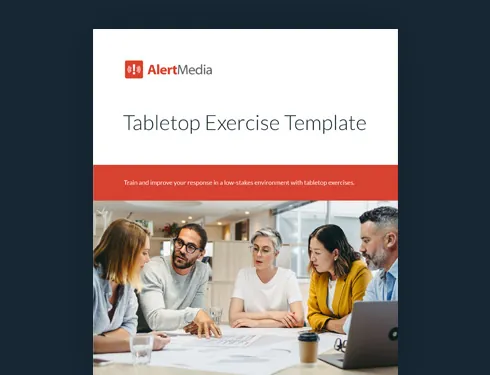
The Benefits of Tabletop Tests in Emergency Management
When disaster strikes, it’s too late to prepare. Here’s how a tabletop test can help you turn your emergency management plan into a well-oiled machine long before you need to deploy your response.

Just like any skill set, responding to an emergency situation requires practice. But you don’t want to wait until your third or fourth emergency to master your response. The best time to test out your emergency response is long before you get the threat alert. But there’s no need to launch a full-scale drill of a disaster scenario to do so. You can simply run a tabletop test with your key personnel to practice your emergency and risk management skills.
A wide range of organizations use tabletop tests to evaluate and improve their preparedness, response, coordination, and decision-making abilities in emergency situations. These discussion-based exercises are valuable for any business seeking to enhance their readiness and resilience to better protect their employees and business operations.
Tabletop Exercise Template
What Is a Tabletop Test?
A tabletop test, also known as a tabletop exercise (TTX) or tabletop scenario, is a form of simulation or role-playing exercise that involves key stakeholders gathering to discuss and evaluate their plans for a hypothetical scenario or emergency situation.
During a tabletop test, participants take on different roles or departments within an organization to engage in facilitated discussions and decision-making processes based on the scenario. Tabletop tests can be performed for a range of situations, such as a natural disaster, a cyberattack, a public health crisis, or a terrorist incident. The purpose of the exercise is to assess an organization’s plans, procedures, and coordination mechanisms, as well as identify strengths, weaknesses, and areas for improvement.
Why Use Tabletop Tests to Prepare for an Emergency?
Tabletop tests are one of many strategies that can be used to prepare your team to navigate an emergency. But they offer a few specific benefits that make them an ideal choice for businesses large and small.
Improving preparedness
Firstly, tabletop tests enhance preparedness by identifying strengths, weaknesses, and gaps in your response plans. Organizations can refine their response protocols and procedures through these simulations to ensure better readiness for real-life crises. These exercises also aid in risk identification by revealing threats that may come up in the middle of an incident, which improves your preparedness by allowing proactive measures to bolster security and resilience.
Strengthening critical thinking
Tabletop exercises also develop your team’s decision-making skills by simulating emergency scenarios and prompting on-the-fly thinking. This equips stakeholders with the ability to evaluate options and make informed decisions efficiently during an actual crisis. Communication and coordination improvements are another advantage, as these exercises reveal any challenges or gaps and help you fix them before the crux of an event.
Connecting your team members
Furthermore, tabletop tests promote team building and collaboration by bringing stakeholders together, fostering relationships, and developing a shared understanding of roles and responsibilities. This collaborative environment enhances coordination and your overall response capacity.
Initiating plan improvements
The process of conducting tabletop tests also facilitates the identification of lessons learned and areas for improvement. Through the debriefings and analysis in the exercise, organizations can continuously refine their emergency response plans, update protocols, and incorporate best practices, thereby improving their preparedness and response capabilities over time.
Lowering stakes and costs
Lastly, tabletop tests are cost-effective compared to full-scale exercises or real emergencies. They require fewer resources and can be conducted more frequently than real emergency drills. They can also provide a safe learning environment to test and refine emergency response strategies and ask questions. This minimizes potential risks and costs associated with live exercises while still achieving valuable learning outcomes.
Overall, tabletop tests are the perfect tool for building upon and improving your emergency response, and they can be used in accompaniment to other preparedness strategies such as running full-scale emergency response plan drills, after-action reports or hot washes, and other functional exercises.
What kind of tabletop tests can you run?
The most common types of tabletop tests vary by industry, organization, and specific objectives. Here are some widely used tabletop test formats:
- Emergency response tabletop exercise—Simulate various crisis scenarios, allowing your participants to discuss and make decisions based on their roles and responsibilities
- Cybersecurity tabletop exercise—Simulate cyber threats and incidents to assess your readiness and response capabilities in the event of a cyberattack such as ransomware
- Business continuity tabletop exercise—Simulate your ability to maintain critical business operations during disruptions, such as natural disasters or infrastructure failures; facilitators evaluate business continuity plans, communication strategies, and overall decision-making processes
- Pandemic or public health tabletop exercise—Simulate public health crises, such as pandemics or disease outbreaks to assess your preparedness for managing health emergencies
- Crisis communication tabletop exercise—Simulate how to effectively communicate with stakeholders, media, and the public during crises, ensuring consistent messaging and timely updates
- Incident response tabletop exercise—Simulate your organization’s ability to respond to specific incidents, such as a chemical spill, industrial accident, or natural disaster; discuss incident response plans, decision-making processes, and coordination among different teams and stakeholders
It’s important to note that these are just a few examples, and the tabletop tests you run for your business should be customized to meet your specific needs and objectives based on your industry, potential risks, and operational context.
Best Practices for Building and Running Tabletop Tests
Running successful tabletop tests requires careful planning, effective facilitation, and thorough evaluation. Here are some best practices to consider:
- Clear objectives: Define specific objectives and desired outcomes for the tabletop test. Knowing ahead of time what aspects of emergency preparedness, response, or coordination you want to evaluate and improve will help you get the most out of your time.
- Realistic scenarios: Design realistic potential scenarios that align with your organization’s risks and challenges. The scenarios should be challenging but achievable so participants can engage without feeling overwhelmed.
- Engage stakeholders: Involve key stakeholders from various departments or organizations that would be part of the actual response effort. This promotes buy-in, collaboration, and a more comprehensive evaluation of response plans.
- Document lessons learned and action items: After the exercise, establish what you learned, including identified strengths and areas for improvement. Then document any action items and assign responsibilities for addressing the identified improvements.
- Repeat and revise: Regularly conduct tabletop tests to maintain preparedness and assess progress over time. Revise scenarios and objectives to address new risks and changes in the organization’s context.
By adhering to these best practices, you can conduct effective tabletop tests that yield valuable insights, foster collaboration, and enhance your overall emergency preparedness and response capabilities.
Practice Makes Prepared
Planning for an emergency is critical, and practicing your response is the best way to shore up vulnerabilities and train your team to act quickly and effectively. Tabletop tests and other simulated walkthrough types of exercises are tools that can be greatly helpful at maximizing your emergency preparedness, so as soon as you get the notification of a severe weather event, cyberattack, or other critical event, you don’t have to second guess your actions.





